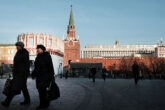September 09, 2025
Melting Arctic Ice is a National Security Threat
This article was originally published on InkStick.
In late July, Russia launched “July Storm,” a major maritime naval exercise that took place across the Pacific, Arctic, Baltic, and Caspian Seas. Shortly afterwards, NATO deployed a maritime force group to the Arctic, focused on anti-submarine activities to protect undersea cables and ensure freedom of navigation in the region. These exercises came on the back of an increased focus on the Arctic as a region for geostrategic competition. US President Donald Trump’s attempts to “buy” Greenland, while clumsy, hint at the importance of the region for American national security. At the same time, the Arctic would have a critical role in the so-called “Golden Dome” missile defense project, should that come to fruition. But there is another factor driving this competition — rising global temperatures.
The United States is woefully unprepared to address the challenging and changing geostrategic environment in the Arctic. Russia, on the other hand, is positioned and primed to take advantage of the coming changes.
China’s footprint in the Arctic is already growing, and the development of civil-military capabilities in some of its established polar research stations could provide the foundation for future Arctic endeavors.
Melting Arctic ice is also making competition in the region more likely — as more energy resources and shipping lines become accessible — but it is also contributing to the overall rate of climate change. Arctic sea ice reflects solar heat back into the atmosphere, insulating the ocean below. As that ice melts, the polar cap reflects less light, further accelerating climate change. On top of that, as the sea warms, it disrupts ocean currents and weather patterns worldwide, deepening the effects of climate change in many locations.
As the effects of climate change intensify, increased competition over resources and access in the Arctic is almost inevitable — but it doesn’t have to result in conflict. Efforts to respond to the risk of conflict in the Arctic should be twofold: firstly, redoubling efforts to slow the overall rate of climate change, and secondly, ensuring the United States and its allies are adequately prepared for any potential future conflict in the region.
Read the full article on InkStick.
More from CNAS
-
Ukraine Negotiations: Prospects and Pitfalls of Peace
This week Brussels Sprouts breaks down the latest negotiations on Ukraine. American officials told reporters that they had resolved or closed gaps around 90 percent of their d...
By Andrea Kendall-Taylor & Jim Townsend
-
Can the Global Order Be Saved? Not Without Punishing Russia
The only way to succeed in the urgent task of achieving a just peace settlement, therefore, is radically reshaping Russia’s calculus....
By Nicholas Lokker
-
CNAS Insights | Russia Is Winning the Battle for Influence in Nigeria
Across Africa, Russia and its proxies are well known for providing security and extracting wealth. In the Sahel the Wagner Group, and subsequently the Russian Defense Ministry...
By Kate Johnston
-
Transatlantic Tensions in the New National Security Strategy
On December 4th, the Trump administration released its long-awaited national security strategy, sending another round of shock waves through the transatlantic community. The N...
By Andrea Kendall-Taylor & Jim Townsend




